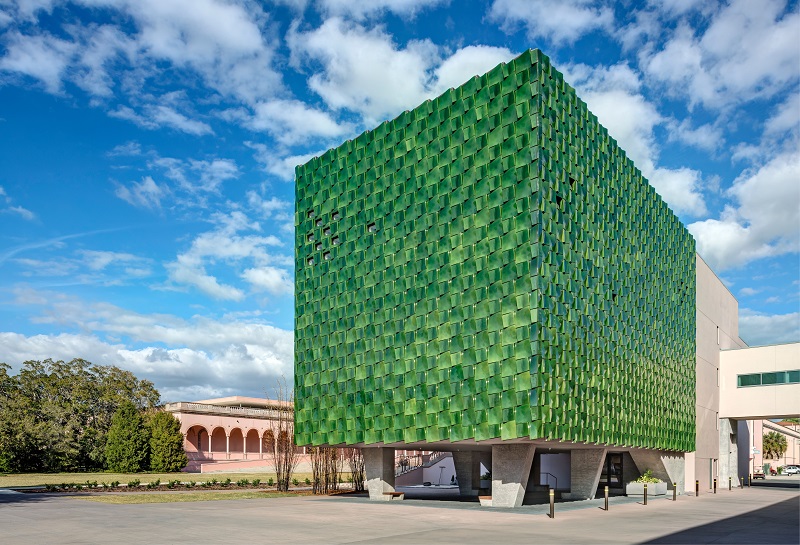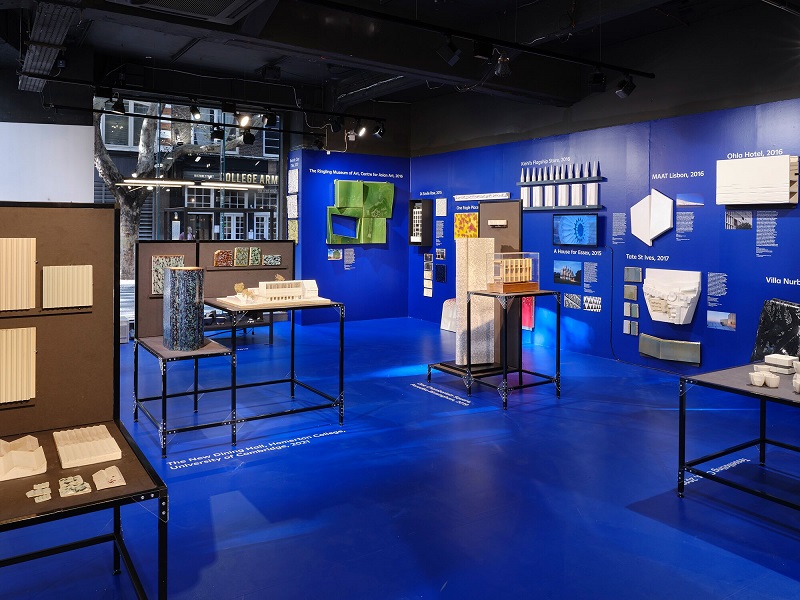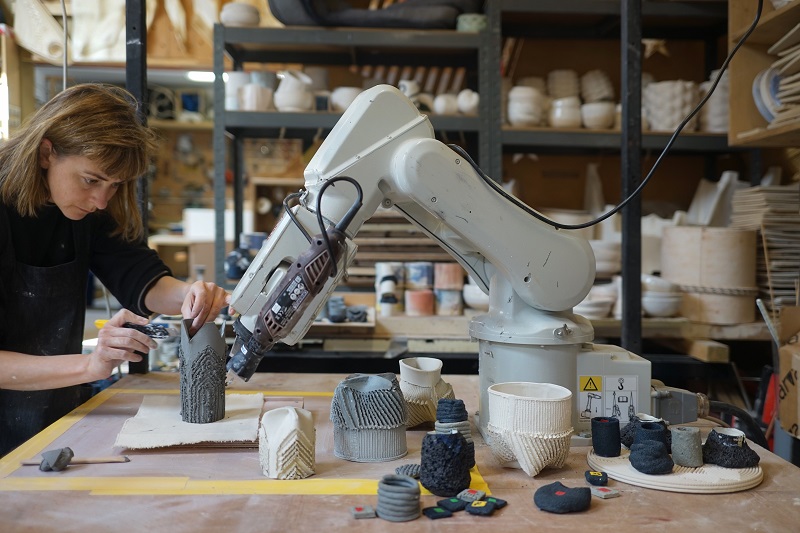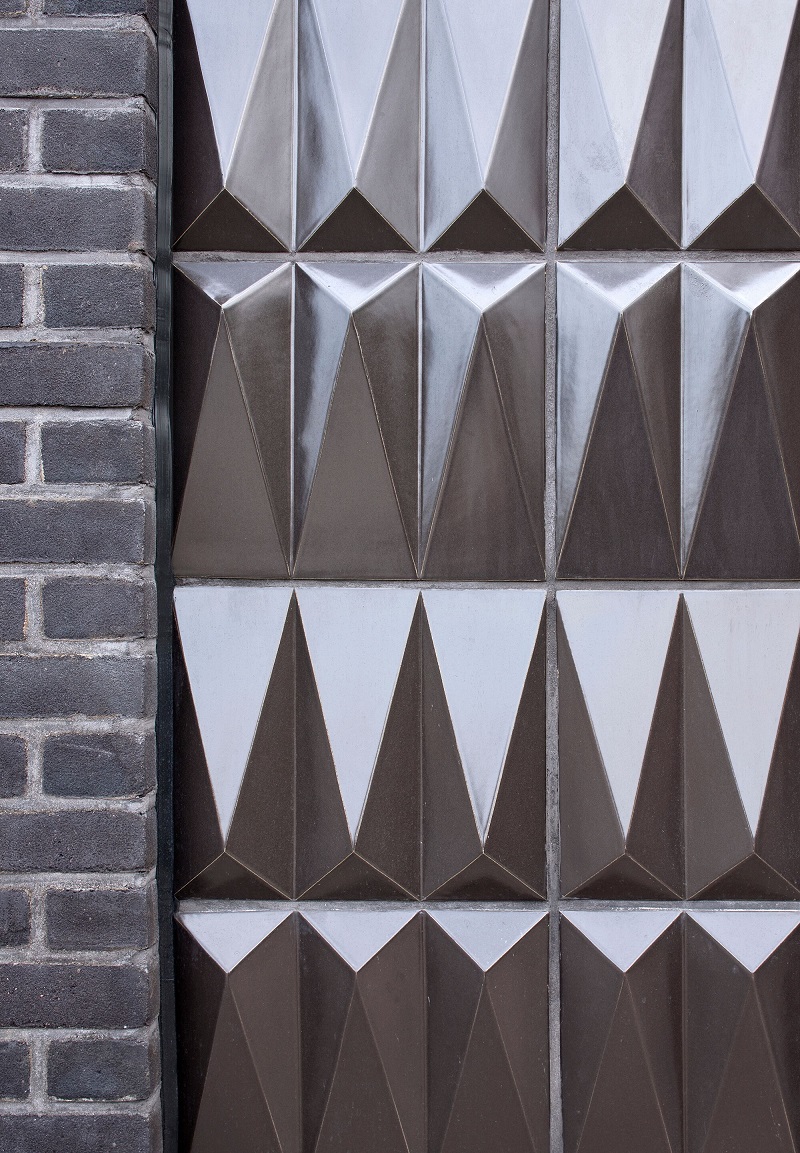Ceramics at The Building Centre

|
| The Ringling Museum of Art Centre for Asian Art, Boston Valley Terra Cotta, 2016. Machado Silvetti Architects. The new pavilion is clad in 3,000 jade-coloured glazed ceramic panels produced individually at the Boston Valley Terra Cotta facilities in Upstate New York, by RAM press, hand press and slip-cast forming methods, and installed on an aluminium track-and-clip system. Photo: Anton Grassi. |
Whether terracotta, faience, vitreous China, porcelain or other artefacts, ceramics have been used throughout history for both functional and decorative purposes. Their lasting appeal has also created a revival of interest in the past few years. So, it is timely that The Building Centre’s latest exhibition explores the role that ceramics play in contemporary architecture and focuses on the diversity of use – from hand-held objects to urban-scale interventions.
‘Hand Held to Super Scale’ tells the story of architectural ceramics, showcasing ground-breaking projects involving collaborations between architects, artists and makers. The show spans the entire gamut of ceramic usage, from glazed household items that inspire whole building facades to the manufacturers who use scaled-up processes familiar to studio potters. Showcasing traditional production methods with innovative technology adds dynamism to the event as hand-crafted pieces contrast with mass ceramic production and robotic arms.

|
| The exhibition brings together designers, artists, ceramicists, manufacturers and small-scale makers to show how contemporary ceramics are helping create inspiring spaces. The project explores the production of ceramics and creates a ‘tactile glossary’ so that visitors can learn through seeing and touching. Photo: John MacLean |
A major theme of the show is the architect-manufacturer-developer-ceramic artist collaborative partnerships that should be at the heart of projects and which are essential to push the boundaries in ceramic production. Practices and artists featured included Eric Parry Architects, Richard Deacon and Jamie Fobert, to more emerging talents such as Turner Prize-winning Assemble and Stirling Prize-nominated Feilden Fowles.

|
| Robotic arm. Photo: John MacLean |
One of the star features on display is the robotic arm created by researchers at Grymsdyke Farm for making clay constructions. Also of note are the innovative and creative schemes such as the bespoke tile production by Assemble; a sound installation made up of experimental ceramic surfaces by ECAlab; prototype elements for Homerton Hall by Feilden Fowles; façade samples from Penoyre & Prasad’s Brunel University building; iridescent tiles from the Stirling Prize nominated Tate St Ives by Jamie Fobert Architects; examples of the collaboration between Eric Parry and artist Richard Deacon for One Eagle Place, and work from seminal Spanish studio Ceràmica Cumella.
Jenny Watt, The Building Centre (co-curator of the exhibition) said: “We wanted to show how collaborations between artists, designers, manufacturers and studio potters can culminate in buildings that are full of beauty and craftmanship. But the show is not simply about decoration – we explore a mix between traditional and experimental manufacturing techniques, proving that the ancient craft of ceramics has a firm place in contemporary architecture.”
Lydia Johnson, Fettle Studio (co-curator of the exhibition) said: "I find it exciting to think that the coffee cup in your hand, the bathroom tiles on your wall, and the cladding on many ground-breaking buildings are made of the same stuff, and for the most part, in the same way. This fascinating parallel of one material through scale, allows the smallest of studio potters to experiment, and the largest of manufacturers to fabricate, in conversation with architects and designers, to bring the charm, character and personality of handmade ceramics into the big world of construction."
‘Hand Held to Super Scale’ is curated by the Building Centre and Fettle Studio, a ceramic studio led by architect Lydia Johnson.

|
| Haddo Yard, Denizen Works, 2017. This project includes bespoke tiles which reference the faience tiles throughout Whitstable, Kent. |
[edit] About The Building Centre
The Building Centre is a not-for-profit organisation dedicated to, ‘…providing education, information and inspiration to all sectors of the built environment as well as the general public’. It is located on South Crescent, 26 Store Street, London WC1E 7BT. Nearest tube station is Goodge Street (Northern Line).
[edit] Related articles on Designing Buildings Wiki
Featured articles and news
Key points for construction at a glance with industry reactions.
Functionality, visibility and sustainability
The simpler approach to specification.
Architects, architecture, buildings, and inspiration in film
The close ties between makers and the movies, with our long list of suggested viewing.
SELECT three-point plan for action issued to MSPs
Call for Scottish regulation, green skills and recognition of electrotechnical industry as part of a manifesto for Scottish Parliamentary elections.
UCEM becomes the University of the Built Environment
Major milestone in its 106-year history, follows recent merger with London School of Architecture (LSE).
Professional practical experience for Architects in training
The long process to transform the nature of education and professional practical experience in the Architecture profession following recent reports.
A people-first approach to retrofit
Moving away from the destructive paradigm of fabric-first.
International Electrician Day, 10 June 2025
Celebrating the role of electrical engineers from André-Marie Amperè, today and for the future.
New guide for clients launched at Houses of Parliament
'There has never been a more important time for clients to step up and ...ask the right questions'
The impact of recycled slate tiles
Innovation across the decades.
EPC changes for existing buildings
Changes and their context as the new RdSAP methodology comes into use from 15 June.
Skills England publishes Sector skills needs assessments
Priority areas relating to the built environment highlighted and described in brief.
BSRIA HVAC Market Watch - May 2025 Edition
Heat Pump Market Outlook: Policy, Performance & Refrigerant Trends for 2025–2028.
Committing to EDI in construction with CIOB
Built Environment professional bodies deepen commitment to EDI with two new signatories: CIAT and CICES.
Government Grenfell progress report at a glance
Line by line recomendation overview, with links to more details.
An engaging and lively review of his professional life.
Sustainable heating for listed buildings
A problem that needs to be approached intelligently.
50th Golden anniversary ECA Edmundson apprentice award
Deadline for entries has been extended to Friday 27 June, so don't miss out!
CIAT at the London Festival of Architecture
Designing for Everyone: Breaking Barriers in Inclusive Architecture.
Mixed reactions to apprenticeship and skills reform 2025
A 'welcome shift' for some and a 'backwards step' for others.


























